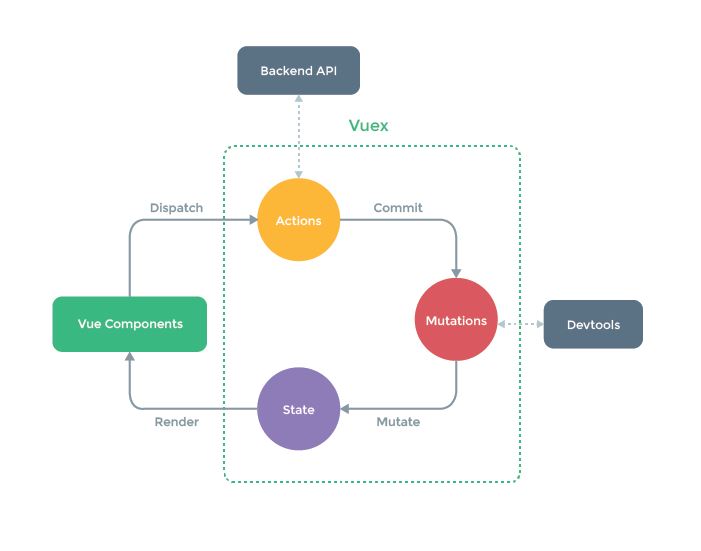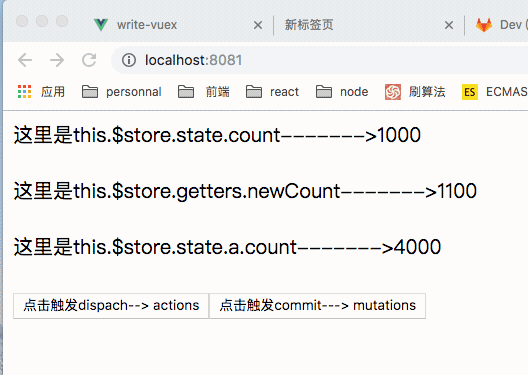这篇文章给大家分享的是有关vuex工作流程是怎么样的的内容。小编觉得挺实用的,因此分享给大家做个参考,一起跟随小编过来看看吧。
大家都知道vuex是vue的一个状态管理器,它采用集中式存储管理应用的所有组件的状态,并以相应的规则保证状态以一种可预测的方式发生变化。先看看vuex下面的工作流程图

通过官方文档提供的流程图我们知道,vuex的工作流程,
1、数据从state中渲染到页面;
2、在页面通过dispatch来触发action;
3、action通过调用commit,来触发mutation;
4、mutation来更改数据,数据变更之后会触发dep对象的notify,通知所有Watcher对象去修改对应视图(vue的双向数据绑定原理)。
使用vuex
理解vuex的工作流程我们就看看vuex在vue中是怎么使用的。
首先用vue-cli创建一个项目工程,如下图,选择vuex,然后就是一路的回车键

安装好之后,就有一个带有vuex的vue项目了。
进入目录然后看到,src/store.js,在里面加了一个状态{count: 100},如下
import Vue from 'vue'
import Vuex from 'vuex' // 引入vuex
Vue.use(Vuex) // 使用插件
export default new Vuex.Store({
state: {
count: 100 // 加一个状态
},
getter: {
},
mutations: {
},
actions: {
}
})最后在App.vue文件里面使用上这个状态,如下
<template>
<div id="app">
这里是stort------->{{this.$store.state.count}}
</div>
</template>
<script>
export default {
name: 'app'
}
</script>
<style>
</style>项目跑起来就会看到页面上看到,页面上会有100了,如下图

到这里我们使用vuex创建了一个store,并且在我们的App组件视图中使用,但是我们会有一些列的疑问。
store是如何被使用到各个组件上的??
为什么state的数据是双向绑定的??
在组件中为什么用this.$store.dispch可以触发store的actions??
在组件中为什么用this.$store.commit可以触发store的mutations??
....等等等等
带着一堆问题,我们来自己实现一个vuex,来理解vuex的工作原理。
安装并使用store
在src下新建一个vuex.js文件,然后代码如下
'use strict'
let Vue = null
class Store {
constructor (options) {
let { state, getters, actions, mutations } = options
}
}
// Vue.use(Vuex)
const install = _Vue => {
// 避免vuex重复安装
if (Vue === _Vue) return
Vue = _Vue
Vue.mixin({
// 通过mixins让每个组件实例化的时候都会执行下面的beforeCreate
beforeCreate () {
// 只有跟节点才有store配置,所以这里只走一次
if (this.$options && this.$options.store) {
this.$store = this.$options.store
} else if (this.$parent && this.$parent.$store) { // 子组件深度优先 父 --> 子---> 孙子
this.$store = this.$parent.$store
}
}
})
}
export default { install, Store }然后修改store.js中的引入vuex模块改成自己的vuex.js
import Vuex from './vuex' // 自己创建的vuex文件
在我们的代码中export default { install, Store }导出了一个对象,分别是install和Store
install的作用是,当Vue.use(Vuex)就会自动调用install方法,在install方法里面,我们用mixin混入了一个beforeCreate的生命周期的钩子函数,使得当每个组件实例化的时候都会调用这个函数。
在beforeCreate中,第一次根组件通过store属性挂载$store,后面子组件调用beforeCreate挂载的$store都会向上找到父级的$store,这样子通过层层向上寻找,让每个组件都挂上了一个$store属性,而这个属性的值就是我们的new Store({...})的实例。如下图

通过层层向上寻找,让每个组件都挂上了一个$store属性设置state响应数据
通过上面,我们已经从每个组件都通过this.$store来访问到我们的store的实例,下面我们就编写state数据,让其变成双向绑定的数据。下面我们改写store类
class Store {
constructor (options) {
let { state, getters, actions, mutations } = options // 拿到传进来的参数
this.getters = {}
this.mutations = {}
this.actions = {}
// vuex的核心就是借用vue的实例,因为vuex的数据更改回更新视图
this._vm = new Vue({
data: {
state
}
})
}
// 访问state对象时候,就直接返回响应式的数据
get state() { // Object.defineProperty get 同理
return this._vm.state
}
}传进来的state对象,通过new Vue({data: {state}})的方式,让数据变成响应式的。当访问state对象时候,就直接返回响应式的数据,这样子在App.vue中就可以通过this.$store.state.count拿到state的数据啦,并且是响应式的呢。
编写mutations、actions、getters
上面我们已经设置好state为响应式的数据,这里我们在store.js里面写上mutations、actions、getters,如下
import Vue from 'vue'
import Vuex from './vuex' // 引入我们的自己编写的文件
Vue.use(Vuex) // 安装store
// 实例化store,参数数对象
export default new Vuex.Store({
state: {
count : 1000
},
getters : {
newCount (state) {
return state.count + 100
}
},
mutations: {
change (state) {
console.log(state.count)
state.count += 10
}
},
actions: {
change ({commit}) {
// 模拟异步
setTimeout(() => {
commit('change')
}, 1000)
}
}
})配置选项都写好之后,就看到getters对象里面有个newCount函数,mutations和actions对象里面都有个change函数,配置好store之后我们在App.vue就可以写上,dispatch和commit,分别可以触发actions和mutations,代码如下
<template>
<div id="app">
这里是store的state------->{{this.$store.state.count}} <br/>
这里是store的getter------->{{this.$store.getters.newCount}} <br/>
<button @click="change">点击触发dispach--> actions</button>
<button @click="change1">点击触发commit---> mutations</button>
</div>
</template>
<script>
export default {
name: 'app',
methods: {
change () {
this.$store.dispatch('change') // 触发actions对应的change
},
change1 () {
this.$store.commit('change') // 触发mutations对应的change
}
},
mounted () {
console.log(this.$store)
}
}
</script>数据都配置好之后,我们开始编写store类,在此之前我们先编写一个循环对象工具函数。
const myforEach = (obj, callback) => Object.keys(obj).forEach(key => callback(key, obj[key]))
// 作用:
// 例如{a: '123'}, 把对象的key和value作为参数
// 然后就是函数运行callback(a, '123')工具函数都准备好了,之后,下面直接县编写getters、mutations和actions的实现
class Store {
constructor (options) {
let { state = {}, getters = {}, actions = {}, mutations = {} } = options
this.getters = {}
this.mutations = {}
this.actions = {}
// vuex的核心就是借用vue的实例,因为vuex的数据更改回更新视图
this._vm = new Vue({
data: {
state
}
})
// 循环getters的对象
myforEach(getters, (getterName, getterFn) => {
// 对this.getters对象进行包装,和vue的computed是差不多的
// 例如 this.getters['newCount'] = fn(state)
// 执行 this.getters['newCount']()就会返回计算的数据啦
Object.defineProperty(this.getters, getterName, {
get: () => getterFn(state)
})
})
// 这里是mutations各个key和值都写到,this.mutations对象上面
// 执行的时候就是例如:this.mutations['change']()
myforEach(mutations, (mutationName, mutationsFn) => {
// this.mutations.change = () => { change(state) }
this.mutations[mutationName] = () => {
mutationsFn.call(this, state)
}
})
// 原理同上
myforEach(actions, (actionName, actionFn) => {
// this.mutations.change = () => { change(state) }
this.actions[actionName] = () => {
actionFn.call(this, this)
}
})
const {commit , dispatch} = this // 先存一份,避免this.commit会覆盖原型上的this.commit
// 解构 把this绑定好
// 通过结构的方式也要先调用这类,然后在下面在调用原型的对应函数
this.commit = type => {
commit.call(this, type)
}
this.dispatch = type => {
dispatch.call(this, type)
}
}
get state() { // Object.defineProperty 同理
return this._vm.state
}
// commi调用
commit (type) {
this.mutations[type]()
}
// dispatch调用
dispatch (type) {
this.actions[type]()
}
}通过上面的,我们可以看出,其实mutations和actions都是把传入的参数,赋值到store实例上的this.mutations和this.actions对象里面。
当组件中this.$store.commit('change')的时候 其实是调用this.mutations.change(state),就达到了改变数据的效果,actions同理。
getters是通过对Object.defineProperty(this.getters, getterName, {})
对this.getters进行包装当组件中this.$store.getters.newCount其实是调用getters对象里面的newCount(state),然后返回计算结果。就可以显示到界面上了。
大家看看完成后的效果图。

到这里大家应该懂了vuex的内部代码的工作流程了,vuex的一半核心应该在这里了。为什么说一半,因为还有一个核心概念module,也就是vuex的数据的模块化。
vuex数据模块化
由于使用单一状态树,应用的所有状态会集中到一个比较大的对象。当应用变得非常复杂时,store 对象就有可能变得相当臃肿。
为了解决以上问题,Vuex 允许我们将 store 分割成模块(module)。每个模块拥有自己的 state、mutation、action、getter、甚至是嵌套子模块——从上至下进行同样方式的分割
例如下面的store.js
// 实例化store,参数数对象
export default new Vuex.Store({
modules: {
// 模块a
a: {
state: {
count: 4000
},
actions: {
change ({state}) {
state.count += 21
}
},
modules: {
// 模块b
b: {
state: {
count: 5000
}
}
}
}
},
state: {
count : 1000
},
getters : {
newCount (state) {
return state.count + 100
}
},
mutations: {
change (state) {
console.log(state.count)
state.count += 10
}
},
actions: {
change ({commit}) {
// 模拟异步
setTimeout(() => {
commit('change')
}, 1000)
}
}
})然后就可以在界面上就可以写上this.$store.state.a.count(显示a模块count),this.$store.state.a.b.count(显示a模块下,b模块的count),这里还有一个要注意的,其实在组件中调用this.$store.dispatch('change')会同时触发,根的actions和a模块的actions里面的change函数。
下面我们就直接去实现models的代码,也就是整个vuex的实现代码,
'use strict'
let Vue = null
const myforEach = (obj, callback) => Object.keys(obj).forEach(key => callback(key, obj[key]))
class Store {
constructor (options) {
let state = options.state
this.getters = {}
this.mutations = {}
this.actions = {}
// vuex的核心就是借用vue的实例,因为vuex的数据更改回更新视图
this._vm = new Vue({
data: {
state
}
})
// 把模块之间的关系进行整理, 自己根据用户参数维护了一个对象
// root._children => a._children => b
this.modules = new ModulesCollections(options)
// 无论子模块还是 孙子模块 ,所有的mutations 都是根上的
// 安装模块
installModules(this, state, [], this.modules.root)
// 解构 把this绑定好
const {commit , dispatch} = this
// 通过结构的方式也要先调用这类,然后在下面在调用原型的对应函数
this.commit = type => {
commit.call(this, type)
}
this.dispatch = type => {
dispatch.call(this, type)
}
}
get state() { // Object.defineProperty 同理
return this._vm.state
}
commit (type) {
// 因为是数组,所以要遍历执行
this.mutations[type].forEach(fn => fn())
}
dispatch (type) {
// 因为是数组,所以要遍历执行
this.actions[type].forEach(fn => fn())
}
}
class ModulesCollections {
constructor (options) { // vuex []
// 注册模块
this.register([], options)
}
register (path, rawModule) {
// path 是空数组, rawModule 就是个对象
let newModule = {
_raw: rawModule, // 对象
_children: {}, // 把子模块挂载到这里
state: rawModule.state
}
if (path.length === 0) { // 第一次
this.root = newModule
} else {
// [a, b] ==> [a]
let parent = path.slice(0, -1).reduce((root, current) => {
return root._children[current]
}, this.root)
parent._children[path[path.length - 1]] = newModule
}
if (rawModule.modules) {
// 遍历注册子模块
myforEach(rawModule.modules, (childName, module) => {
this.register(path.concat(childName), module)
})
}
}
}
// rootModule {_raw, _children, state }
function installModules (store, rootState, path, rootModule) {
// rootState.a = {count:200}
// rootState.a.b = {count: 3000}
if (path.length > 0) {
// 根据path找到对应的父级模块
// 例如 [a] --> path.slice(0, -1) --> [] 此时a模块的父级模块是跟模块
// 例如 [a,b] --> path.slice(0, -1) --> [a] 此时b模块的父级模块是a模块
let parent = path.slice(0, -1).reduce((root, current) => {
return root[current]
}, rootState)
// 通过Vue.set设置数据双向绑定
Vue.set(parent, path[path.length - 1], rootModule.state)
}
// 设置getter
if (rootModule._raw.getters) {
myforEach(rootModule._raw.getters, (getterName, getterFn) => {
Object.defineProperty(store.getters, getterName, {
get: () => {
return getterFn(rootModule.state)
}
})
})
}
// 在跟模块设置actions
if (rootModule._raw.actions) {
myforEach(rootModule._raw.actions, (actionName, actionsFn) => {
// 因为同是在根模块设置,子模块也有能相同的key
// 所有把所有的都放到一个数组里面
// 就变成了例如 [change, change] , 第一个是跟模块的actions的change,第二个是a模块的actions的change
let entry = store.actions[actionName] || (store.actions[actionName] = [])
entry.push(() => {
const commit = store.commit
const state = rootModule.state
actionsFn.call(store, {state, commit})
})
})
}
// 在跟模块设置mutations, 同理上actions
if (rootModule._raw.mutations) {
myforEach(rootModule._raw.mutations, (mutationName, mutationFn) => {
let entry = store.mutations[mutationName] || (store.mutations[mutationName] = [])
entry.push(() => {
mutationFn.call(store, rootModule.state)
})
})
}
// 递归遍历子节点的设置
myforEach(rootModule._children, (childName, module) => {
installModules(store, rootState, path.concat(childName), module)
})
}
const install = _Vue => {
// 避免vuex重复安装
if (Vue === _Vue) return
Vue = _Vue
Vue.mixin({
// 通过mixins让每个组件实例化的时候都会执行下面的beforeCreate
beforeCreate () {
// 只有跟节点才有store配置
if (this.$options && this.$options.store) {
this.$store = this.$options.store
} else if (this.$parent && this.$parent.$store) { // 子组件深度优先 父 --> 子---> 孙子
this.$store = this.$parent.$store
}
}
})
}
export default { install, Store }看到代码以及注释,主要流程就是根据递归的方式,处理数据,然后根据传进来的配置,进行操作数据。
至此,我们把vuex的代码实现了一遍,在我们App.vue的代码里添加
<template>
<div id="app">
这里是store的state------->{{this.$store.state.count}} <br/>
这里是store的getter------->{{this.$store.getters.newCount}} <br/>
这里是store的state.a------->{{this.$store.state.a.count}} <br/>
<button @click="change">点击触发dispach--> actions</button>
<button @click="change1">点击触发commit---> mutations</button>
</div>
</template>最后查看结果。

感谢各位的阅读!关于“vuex工作流程是怎么样的”这篇文章就分享到这里了,希望以上内容可以对大家有一定的帮助,让大家可以学到更多知识,如果觉得文章不错,可以把它分享出去让更多的人看到吧!
免责声明:本站发布的内容(图片、视频和文字)以原创、转载和分享为主,文章观点不代表本网站立场,如果涉及侵权请联系站长邮箱:is@yisu.com进行举报,并提供相关证据,一经查实,将立刻删除涉嫌侵权内容。